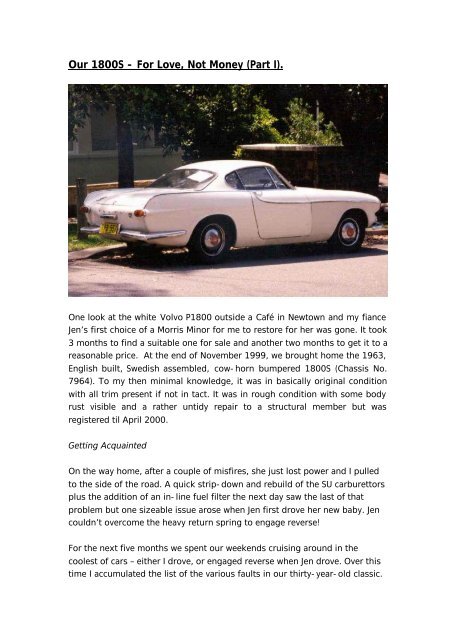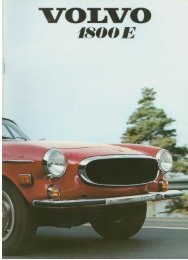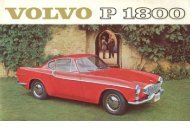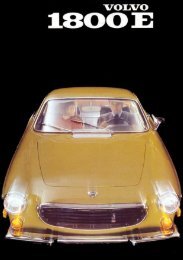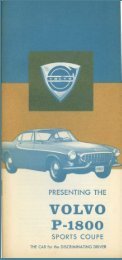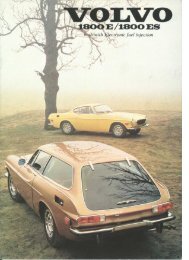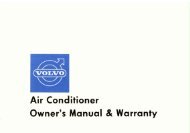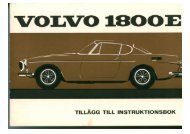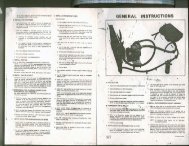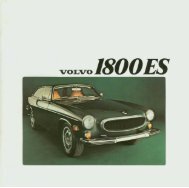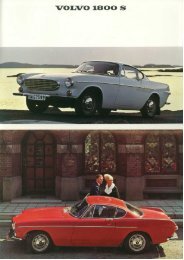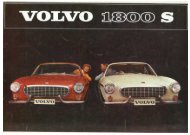Our 1800S - For Love, Not Money (Part I). - Volvo 1800 Picture Gallery
Our 1800S - For Love, Not Money (Part I). - Volvo 1800 Picture Gallery
Our 1800S - For Love, Not Money (Part I). - Volvo 1800 Picture Gallery
- No tags were found...
You also want an ePaper? Increase the reach of your titles
YUMPU automatically turns print PDFs into web optimized ePapers that Google loves.
<strong>Our</strong> <strong><strong>1800</strong>S</strong> - <strong>For</strong> <strong>Love</strong>, <strong>Not</strong> <strong>Money</strong> (<strong>Part</strong> I).One look at the white <strong>Volvo</strong> P<strong>1800</strong> outside a Café in Newtown and my fianceJen’s first choice of a Morris Minor for me to restore for her was gone. It took3 months to find a suitable one for sale and another two months to get it to areasonable price. At the end of November 1999, we brought home the 1963,English built, Swedish assembled, cow-horn bumpered <strong><strong>1800</strong>S</strong> (Chassis No.7964). To my then minimal knowledge, it was in basically original conditionwith all trim present if not in tact. It was in rough condition with some bodyrust visible and a rather untidy repair to a structural member but wasregistered til April 2000.Getting AcquaintedOn the way home, after a couple of misfires, she just lost power and I pulledto the side of the road. A quick strip-down and rebuild of the SU carburettorsplus the addition of an in-line fuel filter the next day saw the last of thatproblem but one sizeable issue arose when Jen first drove her new baby. Jencouldn’t overcome the heavy return spring to engage reverse!<strong>For</strong> the next five months we spent our weekends cruising around in thecoolest of cars – either I drove, or engaged reverse when Jen drove. Over thistime I accumulated the list of the various faults in our thirty-year-old classic.
The cabin was very hot through summer as well as being noisy and tendingto inhale whatever fumes there were from the engine bay. The only gaugesthat worked were the fuel gauge and the inaccurate speedometer – whoneeded the revs, time, oil pressure or oil & water temp anyway? There was aclunking/groaning from the rear whenever we hit a bump although I couldfind nothing loose in the rear end. The electro-hydraulic overdrive did notoperate and more critically nor did the radio. The dangerously worn out frontcarpet that caught heals was quickly replaced with some remnant carpetfrom someone’s lounge room.These things aside the <strong><strong>1800</strong>S</strong> was a joy to drive. While slow off the mark, onthe expressway it came into its own. It cruised effortlessly at 110kph withplenty of legs for overtaking – it was fun watching the faces in far moremodern cars as we glided past them. As far as the drive train was concerned,apart from a noisy gearbox & differential – she purred like a kitten.Reality strikesThe fun stopped when our classic failed its registration check. Rust holes inthe front guards was an easily repairable non-compliance but the cracked a-arm mounts on the front cross-member and the cracked rear strut towersrequired some more serious work (thus answering the question of theclunking rear end).With our wedding in May, the <strong><strong>1800</strong>S</strong> went to the back of the garage to wait. Igave myself a target of two years (April 2002). Married life and catching upon two months work saw few spare nights or weekends to do much with the<strong>Volvo</strong> in July & August. Although it was during this time that I decided on afull restoration rather than just addressing the registration issues and Jen’sproblem with reverse.At the time of the Sydney Olympics, the <strong>1800</strong> came back in the picture as Jenhad extended work hours & I worked from home. Within a month, it wascompletely stripped and I now had a very cramped garage, shoe boxes withlots of individually tagged zip-loc bags and a CD-ROM full of photos of whatcame from where.It was now that I got a clearer picture of the rust problem, the parts requiredand the scope of work to be done. Rust was visibly present in the left frontchassis rail (poorly repaired), the cross bar under the radiator, battery box,front guards (both front seals & lower rear), door sills, doors, rear wheel
arches, beaver tail, boot lip and headlight, indicator & tail-light inserts. Thebody had a ding in the nose, a crease in the front drivers guard and anumber of dents in the back end. The paintwork was crazed on the bonnet &guards, non-existent in the fuel flap and in all there were four different tonesof white. The interior needed complete re-upholstering and the majority ofthe rubber seals fell apart on removal. All the brightwork needed rechromingand some needed repair/replacement. The mechanicals needed the nearlyforty years of build-up removed before they could be stripped & rebuilt.Basically the job again stopped for the best part of eight months. I had beengiven control of a new project at work that took too much of my time. It wasalso probably just as much the size of the task that put me off going near therear of the garage very often.Back in earnestThe eight months were not completely wasted. A trip to Europe had found asupplier whom I made some purchases from including the most usedresource for the restoration – a CD-ROM copy of the original <strong>Volvo</strong> <strong>Part</strong>s &Service manual. The internet was the other crucial resource – the Yahoo e-groups “<strong>1800</strong> List”, eBay & two more suppliers in particular. By June 2001, Iknew more about the P<strong>1800</strong> & <strong><strong>1800</strong>S</strong> than I knew about any other car and Ihad made numerous purchases from around the world. More importantly,we had also paid off our wedding & honeymoon. I had ten months left of mypromised two year project.The BodyworkThe body was the biggest task to get started and I knew I did not have thetime, skills or equipment to cut, weld & beat the body into shape. Threeweeks of visiting panel beaters, body shops & restorers then checkingreferences led to a chassis repair specialist in the North West of Sydney.Front & rear rolling stock was returned along with doors, bonnet & boot andthe shell was trailered to its home for the next four months (as a monthlybudget applied).First was the chemical strip. It left a truly naked shell and a startling view ofthe holes left by the now killed rust. In addition it uncovered previous otherbody repairs: a deep gouge to the right rear quarter panel, a substantialimpact to the rear and a previous rust repair to the LH door sill. I had becomeaware of this when I had great difficulty removing the rear wiring loom which
passes through this sill - the sill had been re-welded with the wiring loomstill inside! The outer sheath and insulation had been melted into a block ofplastic in the middle of the sill, yet surprisingly everything in the rear endstill worked!With the body fully stripped, I was not happy leaving the untidy lookingrepairs to the LH chassis rail. Once the repairs had been ground off, intuitionto remove it proved correct as forward of the cross member was merely veryfine Swiss cheese.Having gone this far, there was only one way forward. Every hint of rust wascut out. Replacement panels were purchased where available (guard sections,sills, wheel arches, rear ¼ panels & indicator inserts) otherwise hand beaten.Panel beating the boot proved one of the more time consuming tasks it wasso out of shape.Once the body was rust free & fairly straight it was primed and the enginebay, interior & boot were painted in the new colour of <strong>Volvo</strong> Pure SilverMetallic. To protect the primer from absorbing greasy handprints I also had
the exterior given a first coat. In mid-November the <strong>1800</strong> came back homefor me to start work mechanically.Other sub-contracted jobsWhile the body was away, various other items received professional attentionas well. The two piece dash was badly cracked so it was given to Departmentof Interior at Carlton who did a fantastic job for an excellent price. The samecan be said for Classic Wiring in Melbourne who refurbished the main wiringloom and replaced the melted rear. The SU carburettors got the fulltreatment at Midel of Lakemba whose high quality finish made me reconsiderthe rest of the engine bay. The differential was reconditioned and all seals &bearings replaced in the rear end. After sand blasting the fuel tank there wasvery little left of the rusted out bottom, so a new base was rolled, welded inand pressure tested.All instruments were stripped & rebuilt by Olympic Instruments of Gordon,again for a very reasonable price. I had purchased a spare tacho & fuel gaugeon eBay for spare parts. As it turned old, technician had worked on thespeedometer back in 1967 as attested by his service tag!The “brightwork” went to a three of electroplaters depending on the size andwork required. Each had their own mishaps and in hindsight the chromeworkhas been the most painfull part of this project. <strong>Part</strong>s were badly repaired,damaged, misplaced, poorly finished and in one case DISSOLVED! I searchedthe internet & chat rooms of the world to find a replacement for that piecewhich saw me drive overnight from Paris to 100km North of Amsterdam andthen back again – the benefit being I slept the whole trip back to Sydney. Iam still awaiting the return of my grille surround that was first shipped offback in July 2001!The interior of the <strong><strong>1800</strong>S</strong> was original but badly in need of renewal and thiswork was shared by two suppliers – both referrals. Restor-a-Dash of Revesbywere recommended for their interior panelwork, particularly as they hadaccess to a <strong>Volvo</strong> stamp for the door trims. While the quality of most of thework eventually received was very good and the prices reasonable, thenumber of phonecalls and visits over a five month period ensured that Iwould never recommend them. The promised turn-around was two weeks.The seat upholsterer whom Restor-a-Dash recommended was the totallyopposite experience, with one phone call to advise he was delayed a weekand the second to say all was ready. J.P.’s Trimmers next door to Restor-a-
Dash were excellent and will also be custom making the carpet when the caris ready.MechanicalsThe engine was running 10psi down on Cylinder #4, the head gasket wasleaking oil and the head was still running unleaded valve seats. Giveneverything else was being stripped, I sent it to the re-conditioner formachining, hardened seats, rings bearings. On return of the short motor, itgot a new cam & lifters for the badly worn ones, and new water pump andthermostats for the rusted out items. At the same time the fuel pump,alternator (non-original), distributor were stripped, cleaned & reconditioned.To make it pretty it got a new coat of fire engine red, polished cam gearcover & thermostat housing, chromed rocker cover and powder coated fan.Re-assembled of the motor included with all new seals, gaskets & bolts ofcourse.Next in line was the gearbox & overdrive. Having not touched gearboxbefore, I avoided this task for about a month but eventually got into it. Oninspection after disassembly, the gearshift extension lever was found to bedeformed which probably didn’t help the gear change either. The gearboxinnards seemed reasonable but got new seals & bearings. The troublesomereverse spring was replaced with a lower spring constant as well asstraightening the extension shaft. (One error was refitting the loose laygearon its shaft which had a sleeve inserted from previous bearing failure. I nowaccept I will have to remove the gearbox again to correct this novices error.)The overdrive proved much simpler than expected. The contacts in the ODsolenoid had long since separated from the solenoid body. A quick visit tothe technicians at work located some nice 24k gold contacts (severe overkill)which quickly solenoid clicking away happily. Mechanically, the friction platesand surfaces were excellent with all teeth cut and bearings spinning freely.The only problem was all the seals had perished so no hydraulic pressurecould be held. Again easily fixed with new o-rings and some home madegaskets.A clutch system saw the main clutch cylinder stripped and rebuilt along withthe slave cylinder down on the bellhousing. A new clutch playte & pressureplate were meant to finish the job but somehow the stroke of the slavecylinder and the new pressure plate of bearing did not go together poer
design. A temporary bracket gained the correct position for the cylinder toactuate the clutch. (Another job yet to be corrected).Reassembly of the drive train was a red-letter day as was the followingweekend when with the help of my mate Phil, the drivetrain was reacquaintedwith the chassis. Another week saw the plumbing & wiringreconnected and the overdrive reconnected with the differential via newuniversals. Nearly two years to day after it was parked, the <strong><strong>1800</strong>S</strong> sparked tolife again.The brakes have only received partial attention so far. The two brakecylinders - reservoir & booster (aftermarket) - were stripped & rebuilt but I’mnot 100% sure that the bores are sealing. The aftermarket booster has alsobeen rebuilt and prettied with a coat of paint. Brake lines were flushed,scrubbed externally & painted, with some of the untidier modifications rerouted.All wheel cylinders were rebuilt with drums & disks machined andnew pads all around. As yet firm, one pump brakes have not been achieved –so more work remains here.With the beasty now mobile with a degree of braking power, the <strong><strong>1800</strong>S</strong> againleft our garage on a trailer for the paint-shop.The Painfully Long Wait for PaintFrom the start of May til the end of July twice-weekly trips to visit slowlypushed the body preparation along. The paint finally hit the body at the startof August in four coats of colour and five coats of clear. The finished job wasclose to perfect. As I told Peter the paint-shop owner – “well worth themoney but not worth the wait”.
Unfortunately, that wait has been made even more painful with a workemergency requiring me to head overseas for nearly a month only two daysafter the <strong>1800</strong> came home. The emergency was the repair of a submarinecable off Singapore that involved a great deal of time sitting around on theship waiting for things to happen. The upside was that it proved the perfectopportunity to start detailing the re-birth of <strong><strong>1800</strong>S</strong> #7964.Still to comeNow that I’m back home, the re-assembly will start in earnest. The exteriorwill get all new or re-chromed trim, a new front windscreen & all new lightlenses. The interior will have its sound & heat insulation upgrade completedthen in with the all newly upholstered seats & trims and new carpet. Thesteering wheel has been refurbished and there are all new rubbers for thewindow, door and body seals. The polished period alloys (courtesy of a clubmember) will go on for daily driving. Also a CD player & concealed stacker &speakers will be concessions to the modern world.Then after a couple of runs around the block, tune the SU’s, sort the brakesand maybe pull that darned gearbox to fix that layshaft. Somewhere in herewe might also squeeze a stainless exhaust and a serious alarm system. Thenoff for registration and those “<strong><strong>1800</strong>S</strong>” plates that have been in storage solong.The TargetHopefully the next couple of months will see the completion of this tale lessthan six month past the original Project deadline – not a bad result given thevarious interferences. Jen will finally have her car & we will get to take ournew toy to the drive-in. If we make it, just let’s not talk about the budget!


